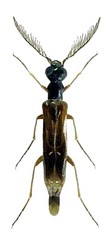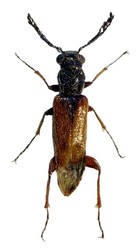Afreminae INCERTAE SEDIS
Dmitry Telnov


This tree diagram shows the relationships between several groups of organisms.
The root of the current tree connects the organisms featured in this tree to their containing group and the rest of the Tree of Life. The basal branching point in the tree represents the ancestor of the other groups in the tree. This ancestor diversified over time into several descendent subgroups, which are represented as internal nodes and terminal taxa to the right.

You can click on the root to travel down the Tree of Life all the way to the root of all Life, and you can click on the names of descendent subgroups to travel up the Tree of Life all the way to individual species.
For more information on ToL tree formatting, please see Interpreting the Tree or Classification. To learn more about phylogenetic trees, please visit our Phylogenetic Biology pages.
close boxIntroduction
Afreminae is a very small group of beetles. Only three species are hitherto described, but there are also some undescribed taxa. The group is distributed in southern Africa, and their representatives are known from Zimbabwe, Zambia, Namibia, SAR and Angola. Nowadays Afreminae formally remains in Anthicidae, but phylogenetic relationships of this group are far from being completely clear.
Characteristics
Adults
Body 4.00-6.50 mm long, ~2.40-3.0 times longer than wide. Dorsal surface densely pubescent.
Head not strongly constricted posteriorly to eyes, not forming narrow neck. Eyes entire, strongly prominent. Insertions of antennae dorsally exposed. Frontoclypeal suture present, slightly impressed. Antennae 11- to 12-segmented. Antennomeres 3 or 4 to 11 each with pair of flat, articulated rami at or near base. Terminal antennomere flattened and expanded apically, rarely subcylindrical. Mandibles long, unidentate.
Pronotum 0.90-1.30 times longer than wide, widest in anterior part. Base distinctly narrower than elytral base. Lateral margins slightly sinuate. Anterior angles not produced, basal angles broadly rounded. Procoxal cavities contiguous, broadly open externally and closed internally.
Elytra ~1.50-2.10 times longer than their maximum combined width. Punctures of disc irregular. Epipleura short or absent. Elytral apices meet at suture or separated by narrow gap; 1-2 terminal ventrites exposed. Mesocoxal cavities contiguous, open laterally. Metacoxal cavities narrowly separated, expanded laterally and meeting lateral margin of elytra. Hind wings with very small radial cell. Medial spur long and straight. CuA2 represented by short distal remnant.
Legs long, slender. Trochanterofemoral attachment oblique, and base of femur is separated from coxa. Metafemora often distinctly enlarged. Meso- and metatibiae spinose or granulate. Tibial spurs paired, long; those on metatibiae often strongly asymmetrical. Tarsal formula 5-5-4. Penultimate tarsomere distinctly bilobate. Claws long.
Abdomen with 6 ventrites. Ventrite I shorter than II. Ventrites I-VII with functional spiracles in their pleural membrane. Aedeagus of tenebrionoid type, symmetrical. Parameres fused, also partly fused to phallobase. Ovipositor, with the exception of baculi, slightly sclerotized.
Preimaginal stages
Larva not described.
Relationships of Afreminae to Other Tenebrionoidea
Afreminae and genus Afremus were originally described as new subfamily and genus of Anthicidae (Levey 1985). The author noticed significant differences of Afremus from other Anthicidae.
The hitherto monotypic genus Dunbrodianus was very recently moved to Afreminae (Lawrence et al. 2010).
Although Afreminae formally remains in Anthicidae, further studies are very necessary to clarify true phylogenetic relationships of this group.
References
Lawrence J.F., Escalona H., Leschen R.A.B. 2010. 11.29. Tenebrionoidea Incertae sedis: 750-760. In: Leschen R.A.B., Beutel R.G., Lawrence J.F. (eds) Coleoptera, Beetles. Volume 2: Morphology and Systematics (Elateroidea, Bostrichiformia, Cucujiformia partim). Arthropoda Insecta. Handbook of Zoology. De Gruyter, Berlin & New York.
Levey B. 1985. Afreminae: a New Subfamily of Anthicidae (Coleoptera) from Southern Africa. - Entomologica scandinavica 15 (1984): 419-422.
Title Illustrations

| Scientific Name | Afremus sp. |
|---|---|
| Location | South Africa |
| Specimen Condition | Dead Specimen |
| Identified By | D.Telnov |
| Sex | Male |
| Life Cycle Stage | imago |
| View | dorsal |
About This Page
Dmitry Telnov

The Entomological Society of Latvia
Correspondence regarding this page should be directed to Dmitry Telnov at
Page copyright © 2010 Dmitry Telnov
All Rights Reserved.
- First online 19 October 2010
- Content changed 19 October 2010
Citing this page:
Telnov, Dmitry. 2010. Afreminae INCERTAE SEDIS. Version 19 October 2010 (under construction). http://tolweb.org/Afreminae/145033/2010.10.19 in The Tree of Life Web Project, http://tolweb.org/









 Go to quick links
Go to quick search
Go to navigation for this section of the ToL site
Go to detailed links for the ToL site
Go to quick links
Go to quick search
Go to navigation for this section of the ToL site
Go to detailed links for the ToL site